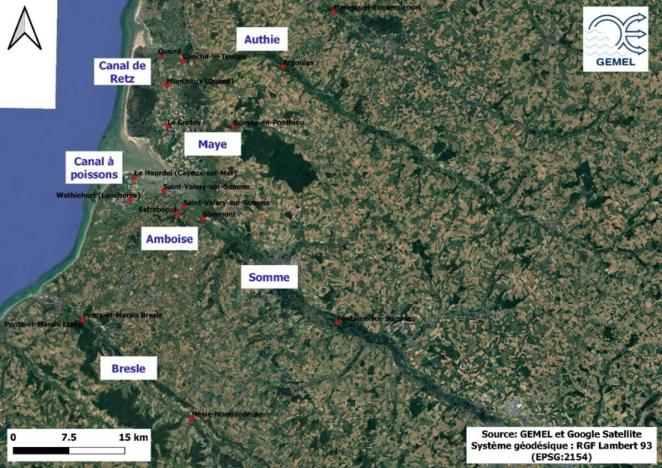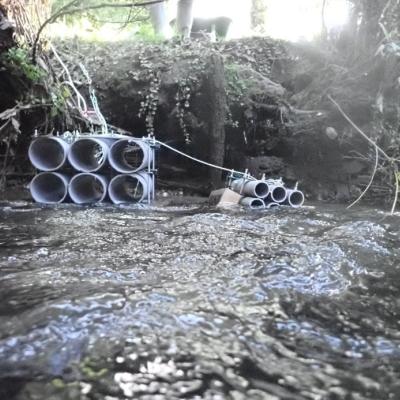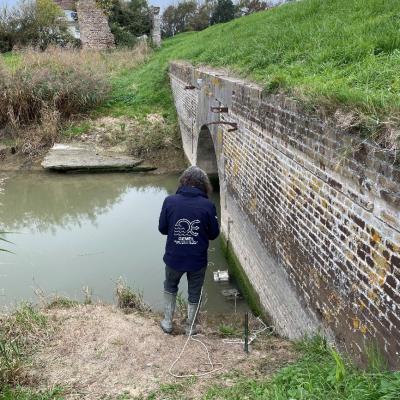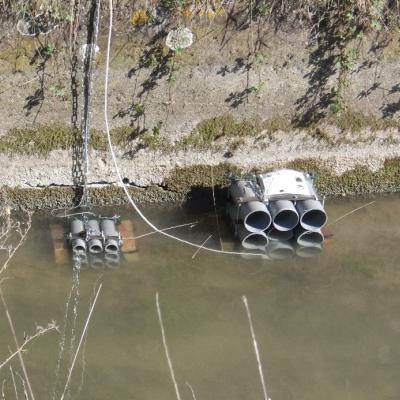Since winter 2023, GEMEL, one of the French organizations involved in the Clancy project, has been actively monitoring the Chinese mitten crabs in Northern France. By introducing innovative condo traps, the team aims to improve detection and control of the invasive species. The first results offer new insights into the spread of aquatic invaders in the region.
GEMEL first started using crustacean traps at a total of 22 sites: 11 rivers monitored in Northern France – Pas-de-Calais, Somme, and Seine-Maritime departments. Despite a total of eight monitoring campaigns during the four different seasons, no Chinese mitten crabs were caught using this type of trap. However, other invasive alien species were caught, including American crayfish, California crayfish, sunfish and muskrat.
Introduction of condo traps
To enhance the effectiveness of monitoring, GEMEL and its partners decided to test a new trap system: the condo trap. These selective traps, made of PVC tubes, are designed to provide shelter for crabs and other crustaceans. Originally developed for capturing invasive crustaceans, particularly Chinese mitten crabs, in San Francisco Bay, the condo traps have shown promising results in Wales.
The trap consists of nine PVC tubes (250 mm long and 50 mm diameter) arranged in a square of 3 by 3. One end of the PVC matrix is covered with fine mesh (2 mm) to prevent specimens from falling out during retrieval. An additional mesh cover (10 mm) surrounds the trap to reinforce the structure and habitat. The open end of the matrix is attached to the surface by a rope and a float. The whole condo is weighted with a diving weight of either 1.3 kg or 2.7 kg, depending on the environmental conditions. The weight is attached to one side to ensure that the condo deploys horizontally when it reaches the target substrate.
First deployment in Northern France

After obtaining the necessary permits, GEMEL deployed this type of trap for the first time between late September and late October 2025, in the Somme and Seine-Maritime departments (i.e. close to the GEMEL premises to optimise monitoring and control of the traps), on 8 rivers (Authie, Canal de Retz, Maye, Canal à Poissons, Amboise, Somme and Bresle rivers) and 16 sites (on the upstream and downstream parts of each river).
Two condo traps were deployed per site: a first condo trap with 50 mm diameter tubes to hold juveniles and a second trap with 100 mm diameter tubes to hold adults (i.e. the largest specimens reaching 80/90 mm). They have been attached to stakes, trees, or rigid structures using chains and padlocks to prevent theft. Labelling has been attached to the trap at the rear mesh. The condo traps have been deployed for 4 consecutive weeks.
Results of the initial monitoring
During the initial monitoring, no Chinese mitten crabs were caught at any of the 16 sites monitored. As with the monitoring using crustacean traps, American crayfish (Faxonius limosus) were caught at certain sites (Maye, Somme and Bresle rivers) as well as green crabs (Carcinus maenas). It should be noted that GEMEL sampled the first brush-clawed shore crab (Hemigrapsus takanoi) in the Somme estuary! This species is usually found in harbour in Northern France.
What does this mean?
Is the absence of the Chinese mitten crab good news for the rivers of Northern France? Indeed, the Chinese mitten crab has been reported and caught in French waterways, but its abundance appears to be lower than in Belgium and Germany.
The rest of the story will be revealed during the next monitoring exercise, which will take place in spring 2026!





